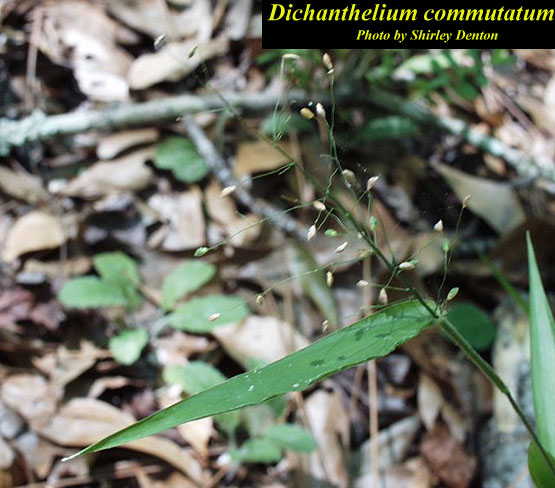Dichanthelium commutatum
Common Names: Variable Panicgrass [1], Variable Witchgrass [2]
| Dichanthelium commutatum | |
|---|---|

| |
| Photo by the Atlas of Florida Plants Database | |
| Scientific classification | |
| Kingdom: | Plantae |
| Division: | Magnoliophyta - Flowering plants |
| Class: | Liliopsida - Moncots |
| Order: | Cyperales |
| Family: | Poaceae |
| Genus: | Dichanthelium |
| Species: | D. communtatum |
| Binomial name | |
| Dichanthelium commutatum Schult. | |

| |
| Natural range of Dichanthelium commutatum from USDA NRCS Plants Database. | |
Contents
[hide]Taxonomic Notes
Synonym: none
Variety: D. commutatum var. ashei (J.A. Shultes) Gould
Description
D. communtatum is a perennial gramioid of the Poaceae family that is native to North America. [1]
Distribution
D. commutatum is found throughout the eastern United States, reaching as far west as Texas and as far north as Maine and Michigan. [1]
Ecology
Habitat
Common habitats for D. commutatum include low, shaded, moist woodlands and edges of woodlands, as well as dry, thin, and rocky woods and thickets. [3]
D. commutatum has a medium tolerance for drought and shade. [1]
This species does not require a moist environment but it can grow in wetter condition. [1]
Phenology
D. commutatum will typically bloom during spring, with April producing the majority of blooms. [4]
Fire ecology
D. commutatum has no tolerance for fire. [1]
Use by animals
This grass can be a supplementary food source for many terrestrial birds. [1]
Conservation and Management
D. commutatum is considered endangered in the state of Illinois. [1]
Cultivation and restoration
Photo Gallery
References and notes
- ↑ Jump up to: 1.0 1.1 1.2 1.3 1.4 1.5 1.6 1.7 USDA Plant Database
- Jump up ↑ Glitzenstein, J. S., et al. (2012). "Fire-frequency effects on vegetation in north Florida pinelands: Another look at the long-term Stoddard Fire Research Plots at Tall Timbers Research Station." Forest Ecology and Management 264: 197-209.
- Jump up ↑ Weakley, A. S. (2015). Flora of the Southern and Mid-Atlantic States. Chapel Hill, NC, University of North Carolina Herbarium.
- Jump up ↑ Pan Flora